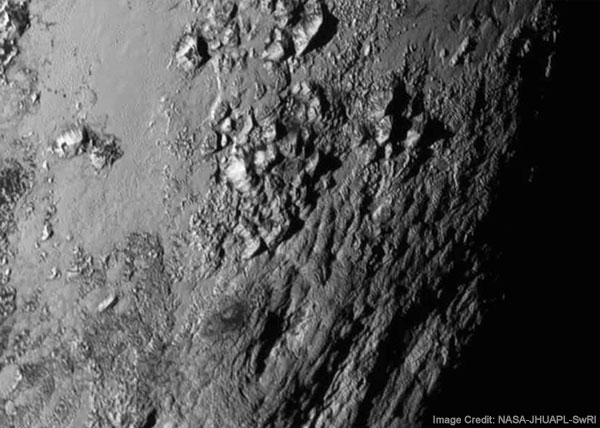Photos transmitted from 4 billion miles away by NASA’s New Horizons Pluto space probe have sparked fresh interest in space exploration.
New Horizons traveled more than 3 billion miles over a nine-and-a-half year stretch to reach the Pluto system.
A close-up image of a region near Pluto’s equator shows a range of mountains reaching up to 11,000 feet in height (see above). The lack of craters suggests they’re relatively new.
“This is one of the youngest surfaces we’ve ever seen in the solar system,” said Jeff Moore, geology, geophysics and imaging team leader at NASA’s Ames Research Center.
The latest image is a view of Charon, the largest of Pluto’s five moons. It shows an interesting feature NASA describes as a “mountain in a moat” — a depression with a peak in the middle. New Horizons took this shot from a distance of 49,000 miles, about an hour and a half before it made its closest approach to Pluto.

An earlier image of Charon surprised scientists because its apparently unmarked surface raises questions about how it escaped being hit by asteroids and other space debris.

An image of Hydra, the outermost known of Pluto’s moons, seems to show it is coated with water ice. New Horizons captured that image when it was approximately 400,000 miles away from the distant moon. Though pixellated, the image reveals important information about Hydra’s physical properties, including the size and shape of the moon and other structural details.

New Awakening?
The general U.S. populace seemed to have settled into ho-hum mode, judging by its tepid reactions to previous achievements in space exploration, but NASA seems to have ignited renewed excitement with the New Horizons mission.
“Without a doubt, we’re seeing terrific public interest,” said Kevin Cook, vice president of marketing and communications at the Space Foundation.
Such discoveries “could impact how we do things on Earth and lead to improved technology for everyday life,” he told TechNewsWorld.
What Else New Horizons Discovered
New Horizons’ photos show that Charon has a 600-mile-long swath of cliffs and troughs, which suggest that internal geological processes created widespread fracturing of the moon’s crust, including a canyon between four and six miles deep on the moon.
In contrast, the Grand Canyon is only 6,000 feet — just over a mile — at its deepest.
Dark surface markings deep in Charon’s north polar region have a diffuse boundary, which might indicate a thin deposit or stain on the surface. NASA team members nicknamed the region “Mordor,” after the dark land in J.R.R. Tolkien’s The Lord of the Rings.
The Mountains of the Moon
The mountains of Pluto probably were formed about 100 million years ago.
That makes them very young, considering the solar system is more than 4.5 billion years old, and suggests the region they’re in — which covers about 1 percent of Pluto’s surface — might still be geologically active now.
However, Pluto can’t be heated by gravitational interactions with a much larger planetary body, which is how such mountain ranges usually are formed on icy moons.
That gives rise to questions about just how the mountains were formed, and may cause scientists to rethink what powers geological activity on other icy worlds.
Flying in a Winter Wonderland
The Pluto system is a scientific wonderland, according to Johns Hopkins University. Its Applied Physics Laboratory designed, built and operates the New Horizons spacecraft, and manages the mission for NASA.
For one thing, Charon’s diameter is 750 miles, more than half that of Pluto, whereas most satellites are much smaller than their parent planets.
Further, the two bodies orbit about a center of mass that’s outside Pluto’s surface, known as a “barycenter,” so they are considered a double planet. No other double planet exists in our solar system.
Astronomers want to learn how Pluto and its moons were formed, and they want to understand why Pluto and Charon look so different.
Pluto’s atmosphere is also of interest. It contains nitrogen, carbon monoxide and methane. The Earth’s atmosphere contains only one gas, water vapor, while Mars has two — water vapor and carbon dioxide.
“We are learning of new surface phenomena and confirmation of the exotic reactions that occur in these outer solar system bodies,” said Jekan Thanga, an assistant professor at Arizona State University’s School of Earth and Space Exploration.
“Currently, all these discoveries are of great scientific interest,” he told TechNewsWorld.
New Frontiers and NASA Budget Cuts
New Horizons is part of NASA’s New Frontiers program — a series of space explorations to research several of the solar system’s planets.
Another New Frontiers program, Juno, consists of a space probe launched in 2011 to explore Jupiter, and OSIRIS-REx (Origins, Spectral Interpretation, Resource Identification, Security, Regolith Explorer), a planned asteroid study and sample-return mission.
Whether the New Frontiers program will encourage more funding for NASA, which repeatedly has been hit by budget cuts under several administrations, is uncertain.
“Anything President Obama did now would have little to no impact during his term, and we’re in the midst of campaigning for our next president,” noted Jim McGregor, principal analyst at Tirias Research.
In the absence of presidential backing, he told TechNewsWorld, “I would not expect Congress to proactively support any such efforts.”
























































Help, help, I need oxygen. Earth has only one gas, Water vapor???????